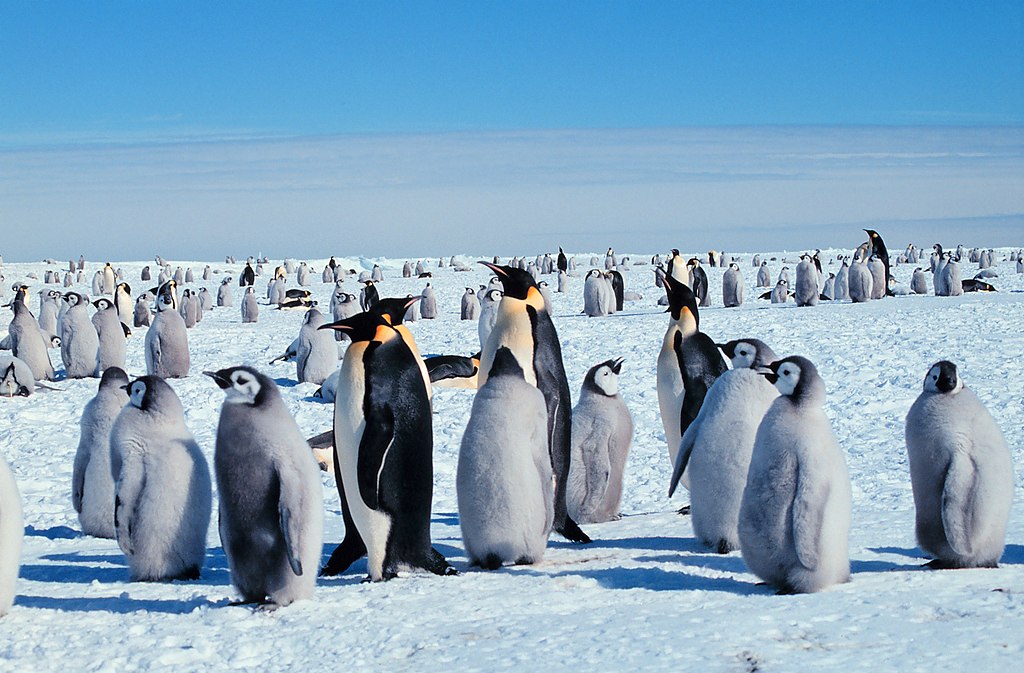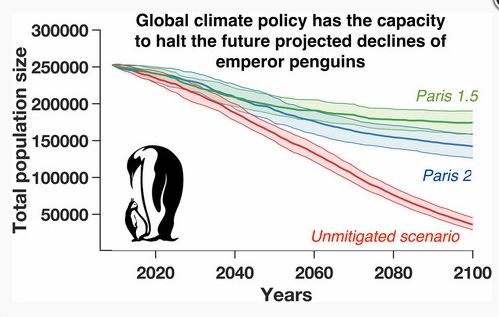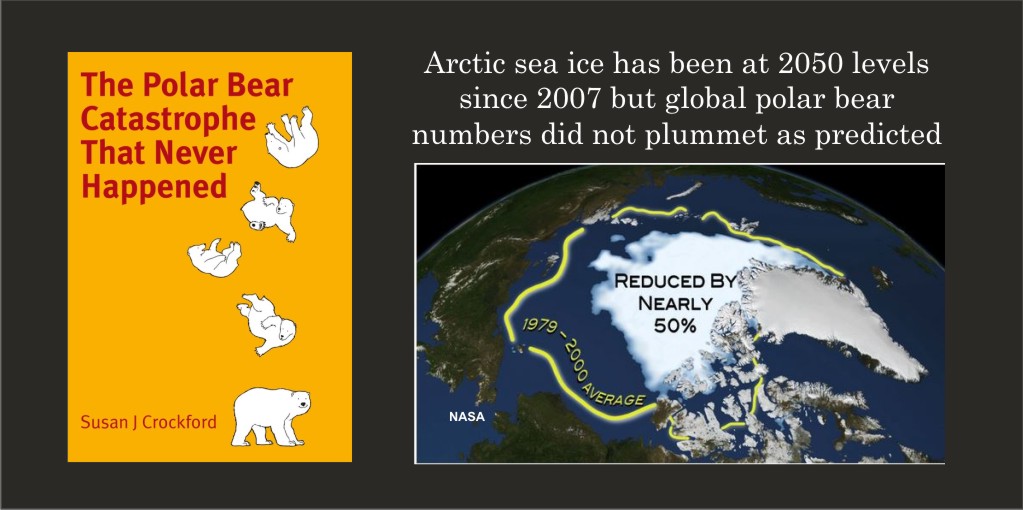From Dr. Susan Crockford’s Polar Bear Science
Posted on August 6, 2020 |
Emperor penguin (Aptenodytes fosteri) populations in 2019 were found to have grown by up to 10% since 2009 – to as many as 282,150 breeding pairs (up from about 256,500) out of a total population of over 600,000 birds (Fretwell et al. 2012; Fretwell and Trathan 2020; Trathan et al. 2020) – despite a loss of thousands of chicks in 2016 when an ice shelf collapsed. Yet, biologists studying this species are currently petitioning the IUCN to upgrade emperor penguins to ‘Vulnerable’ (Trathan et al. 2020), based on models that use the implausible and extreme RCP8.5 ‘worse case‘ climate change scenario (e.g. Hausfather and Peters 2020) that polar bear biologists find so compelling. Not surprisingly, their unscientific models suggest emperor penguins could be close to extinction by 2100 under these unlikely conditions – but if we reduce CO2 emissions via political policy, the penguins will be saved!

Surprisingly, these researchers are going ahead with their petition to have emperor penguins uplisted despite the population increase and the reservations their colleagues expressed in 2018 about using climate change predictions to arrive at a classification of ‘Near Threatened’ for the IUCN Red List assessment (Birdlife International 2018), as noted below in their ‘justification’:
This species is listed as Near Threatened because it is projected to undergo a moderately rapid population decline over the next three generations owing to the projected effects of climate change. However, it should be noted that there is considerable uncertainty over future climatic changes and how these will impact the species.
Like polar bear biologists, some emperor penguin biologists just won’t give up on the prediction they developed back in the mid-2000s that climate change is sure to drive this species to near extinction. For example, Jenouvrier et al. (2009) calculated that there was at least a 36% chance of a 95% or more decline in emperor penguins by 2100 (what they called a “quasi-extinction”) due to changes in sea ice distribution. They suggested a decline of this magnitude would entail a fall from about 6,000 breeding pairs to about 400 in a single colony. The newest model (Jenouvrier et al. 2020) similarly uses the RCP8.5 ‘worse case’ scenario to predict near-extinction by 2100, as their ‘graphic abstract’ below shows.

This group are also recommending that “the species is listed by the Antarctic Treaty as an Antarctic Specially Protected Species” that would require a Species Action Plan (Trathan et al. 2020). And as co-author Peter Fretwell told the BBC last fall (9 October 2019):
“Everything we know – all the experts, all the models – tells us that Emperors are going to be in real trouble. We need to pull out all the stops to help them. That’s going to be hard because we know the one thing that’s really going to save them is stabilisation of the global climate.”
Sounds like something a polar bear specialist would say. Except that for polar bears, the catastrophe they keep predicting just won’t happen despite the fact that summer Arctic sea ice has been declining faster than anyone expected – so far, an almost 50% decline in ice has already happened yet global polar bear numbers keep slowly increasing (Crockford 2019; 2020).

I’d suggest that using far-fetched ‘worse case’ scenario predictions to propose an unlikely but scary-sounding future catastrophe isn’t likely to work any better for emperor penguins than it has done for polar bears, especially when the animals keep thriving.
However, some of the papers listed below are open access, so if you’re interested in more details I suggest you have a look. If you’d like a copy of the modelling paper (Jenouvrier et al. 2020), contact me and I’ll send it along. You’ll find more on the emperor penguin conservation issue in this essay by biologist Jim Steele.
References
BirdLife International. 2018. Aptenodytes forsteri. The IUCN Red List of Threatened Species 2018: e.T22697752A132600320. Downloaded on 07 August 2020. https://www.iucnredlist.org/species/22697752/132600320
Crockford, S.J. 2019. The Polar Bear Catastrophe That Never Happened. Global Warming Policy Foundation, London. Available in paperback and ebook formats.
Crockford, S.J. 2020. State of the Polar Bear Report 2019. Global Warming Policy Foundation Report 39, London. pdf here.
Fretwell, P.T., LaRue, M.A., Morin, P., Kooyman, G.L., Wienecke, B., Ratcliffe, N., Fox, A.J., Fleming, A.H., Porter, C. and Trathan, P.N. 2012. An emperor penguin population estimate: the first global, synoptic survey of a species from space. PLoS One 7: e33751 [open access] doi: 10.1371/journal.pone.0033751.
Fretwell, P.T. and Trathan, P.N. 2020. Discovery of new colonies by Sentinel2 reveals good and bad news for emperor penguins. Remote Sensing in Ecology and Conservation [open access], in press. https://doi.org/10.1002/rse2.176
Hausfather, Z. and Peters, G.P. 2020. Emissions – the ‘business as usual’ story is misleading [“Stop using the worst-case scenario for climate warming as the most likely outcome — more-realistic baselines make for better policy”]. Nature 577: 618-620
Jenouvrier, S., Caswell, H., Barbraud, C., Holland, M., Stroeve, J. and Weimerskirch, H. 2009. Demographic models and IPCC climate projections predict the decline of an emperor penguin population. Proceedings of the National Academy of Science USA 106: 1844-1847.
Jenouvrier, S. et al. 2020. The Paris Agreement objectives will likely halt future declines of emperor penguins. Global Change Biology 26(3): 1170-1184. [paywalled] https://onlinelibrary.wiley.com/doi/abs/10.1111/gcb.14864
Trathan, P.N. and others, including Fretwell, P. T. 2020. The emperor penguin – Vulnerable to projected rates of warming and sea ice loss. Biological Conservation 241:108216. [open access] https://doi.org/10.1016/j.biocon.2019.108216
Penguin eggs are known to dissolve in air that contains more than 450 ppm CO2. (Hey, if they can make stuff up, so can I!)
Actually, if water warms and food increases so will the penguin populations. And it would help if scientists would leave them the H*LL alone. No bird species does better with humans constantly interrupting their lives other than the Pigeon.
If scientists want to go study something up close and personal let them study the Polar Bear populations. The bears can always use the extra protein.
More sea ice just means the penguins have to walk further from their nesting sites in order to find open water to fish in. Less sea ice is a blessing for penguins.
Slightly warmer temperatures also means fewer chicks freeze each winter.
MarkW “More sea ice just means the penguins have to walk further from their nesting sites”
Me thinks the Emperor penguins have been nesting in Antarctica long before it became covered in snow and ice …… and with extremely cold temperatures.
When the penguins migrate 25 to 100 miles across the snow/ice to their “nesting ground”, it can only mean one (1) thing.
They are returning every year to their “ancestral nesting site” that was established when the shore of Antarctica was free of snow and ice.
There isn’t a species on the planet that isn’t going to be dead by 2100 according to some stupid IPCC projection.
“Penguin eggs are known to dissolve in air that contains more than 450 ppm CO2.”
Wow atmospheric acidification !! I was not aware of that problem, thanks for posting. ( Don’t give ’em ideas )
Polar bears where the first species to have been declared endangered based not on population DATA but invalid extrapolation of non validated models. Looks like penguins are campaigning to be the second.
The conflict of interest is huge. If you can promote your clique specialty species to some kind of endangered category, it is more worthy of study and gets more grant money. You then do more “work” to underline your initial findings and you are on the gravy train for life.
Now the whole idea of objective science is out of the window, the entire system falls apart. The assumption of good faith is dead and we have a whole class of political activist “justice” warriors gaming the system to push and agenda and live a comfortable life on research grants from the public purse.
Oh my God, it’s air acidification. We’re doomed.
Well said Robert!!!!
Q: Why are there penguins in the antarctic?
A: There are no land predators.
As far as I can tell, that’s the main criterion other than access to the ocean. Penguins exist all over the southern hemisphere including some quite warm places. link
Q: How could climate change affect the antarctic penguins?
A: If the antarctic got warm enough for land predators to survive, penguins would be in big trouble.
If they can keep rats out of Alberta, they can keep them out of Antarctica.
They briefly got in back in 2015 but we chased them back out last year.
Never again
Junk science in action for the pursuit of Rent.
It helps get grants and get published with impact journals if the thing you want to study is “vulnerable.”
If you know nothing, model it!
How can anyone count penguins because they all look the same?
They say the same thing about us.
You count the feet and divid by two.
Governments have nothing better to do at this time, so saving penguins would keep them out of trouble.
There was a similar scare about Adelie Penguins a couple of years back
https://wattsupwiththat.com/2018/03/02/remember-when-we-were-told-penguins-dont-migrate-theyre-dying-never-mind/
But after over a million were found, this front went quiet.
Idiots want to cull seals to reduce shark attacks on humans.
https://www.google.com/amp/s/news.yahoo.com/amphtml/summer-of-the-shark-after-maine-attack-shark-experts-say-the-beasts-are-here-to-stay-020602175.html
I’m with the seals on this…cull the sharks and geniuses positing this idea.
Why not throw environmentalists into the water to feed the sharks?
Win-Win. Right?
So, is their point, other than the ones on their heads, that too many penguins means they are going to wipe out their food sources and then starve? That is the only way penguins could be in trouble when their population KEEPS GROWING. Just like Polar Bears penguins are doing just fine.
A study that uses RCP8.5 has gone of the rails before it starts.
The reports ought to be placed on the “Science Fiction and Fantasy” shelf.
A Representative Concentration Pathway (RCP) is a gas concentration trajectory adopted by the IPCC.
The scenarios include a ‘pathway’ – the trajectory of greenhouse gas concentrations over time to reach a particular radiative forcing at 2100.
RCP8.5 assumes the carbon dioxide concentration in the atmosphere in 2100 will be 936ppm and this would result in a temperature increase of 4.3 Celsius degrees [7.74 Fahrenheit degrees].
This Pathway is often used in studies because it was promoted as “business as usual” and it shows extreme results.
Others have shown that RCP8.5 is ridiculous because it isn’t happening, and probably could not happen.
Consider the CO2 concentration is now about 416 and the assumption is that it would go to 936, an increase of 520. This requires an average annual increase of 6.5 ppm. In recent years the actual increase has been about 2 ppm.
Because if they are upgraded then there is looooooaaaaads of easy money for them to get their snouts into….